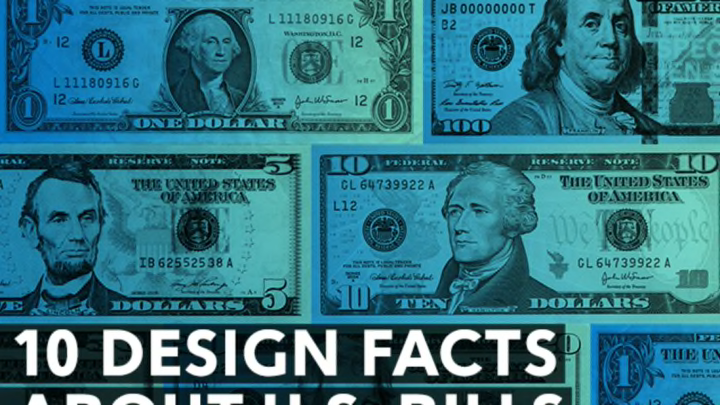We've spent a lot of time combing through information about U.S. paper currency recently and in doing so, turned over some fascinating tidbits about the design efforts involved in giving money its lasting look. Here are a handful of our favorites.
1. WHAT'S WITH ALL THE WHITE MEN?
The portraits on United States paper currency—as selected by the Secretary of the Treasury—were adopted in 1929 when the size of the notes was reduced (although they were modified to improve security against counterfeiting starting in 1996). It was determined that portraits of Presidents of the United States were a logical choice, because they had a more permanent familiarity in the minds of the public than any others. That decision was somewhat altered, however, with the inclusion of three men: Alexander Hamilton, who was the first Secretary of the Treasury; Salmon P. Chase, who was Secretary of the Treasury during the Civil War; and founding father Benjamin Franklin.
2. AND HOW ABOUT ALL THE DECEASED?
Law prohibits portraits of living persons from appearing on Government Securities. Each bill features a portrait of an important historical figure on the obverse, with a vignette of a building or monument on the reverse. The historical figure tends to have a thematic connection to the monument/building chosen.
3. THE BILLS FEATURE REPEAT ARTISTS.
The engravings on the back of the $2 bill (a scene of the Declaration of Independence signing) and front of the $10 bill (a portrait of Alexander Hamilton) are both based on paintings by John Trumbull. The portrait of Jefferson on the $2 bill and the portrait of George Washington on the $1 bill are both based on paintings by Gilbert Stuart.
4. ALL THE PORTRAITS FACE THE SAME WAY, SAVE ONE.
The portrait of Hamilton on the $10 bill faces left, though the portrait on every other bill faces right. The only explanation for this seems to be that the depiction on the bills is lifted directly from original portraits. Guess all the Founding Fathers had the same good side.
Graphic by Chloe Effron
5. HAMILTON WILL REMAIN ON THE UPCOMING REDESIGNED $10 BILL.
A fact which probably has John Adams rolling over in his grave. Adams was not a Hamilton fan. In an 1805 letter to portrait artist John Trumbull, he wrote, “Washington once said to me, that Hamilton was ‘a proud Spirited little Animal, as ever existed.’ Such he was in truth: yet Washington always lived in terror of him. I saw it, and was determined that I would not. I knew his talents and was determined to do him ample justice, but no more.”
6. THE $2 BILL HAS STAYING POWER.
The Charles Burt engraving of Thomas Jefferson (based on Stuart’s portrait) has appeared on $2 bills featuring Jefferson since the 1869 series. Jefferson sat for Stuart three separate times from 1800 to 1805. For the record, while $2 bills seem like a rarity, they are still printed, though not every year. Thirty-two million of them will be printed in 2015 though, so you might see more of them than usual next year. The Fed estimates that about 1.1 billion are in circulation now.
7. PRESIDENT JACKSON HATED PAPER MONEY.
President Andrew Jackson appears on the $20 bill, which is pretty ironic, because the man was hugely opposed to paper money. In his farewell address on March 4, 1837, Jackson said: “The paper system being founded on public confidence and having of itself no intrinsic value, it is liable to great and sudden fluctuations, thereby rendering property insecure and the wages of labor unsteady and uncertain.”
8. THE $50 HAS A SURPRISING EASTER EGG.
On the back of the $50 bill is a view of the United States Capitol, which might seem like a scene that doesn’t have any particular connection to the person on the front—Ulysses S. Grant. In fact, the Ulysses S. Grant monument stands in front of the Capitol building, and while it’s not pictured in the vignette, the monument sits at about the location where one would need to be standing to get the view of the Capitol depicted on the bill.
9. THE NEW $100 WAS INSPIRED BY ARTISTS.
Brian Thompson, a banknote designer at the Bureau of Engraving and Printing, was the lead designer for the new $100. He says the bill’s design was influenced by M.C. Escher and Georgia O’Keeffe. Surely Franklin—a printer himself—would have appreciated the work that goes into the bill, if not the sources of inspiration.
10. THE LIBERTY BELL WASN'T ALWAYS NAMED THAT.
The $100 bill includes an image of the Liberty Bell on the reverse, though it did not become popularly known as the Liberty Bell until the 19th century. So while Franklin might not have known it as such, it did hang in the Pennsylvania State House beginning in the 1750s. In 1755, Franklin referred to the bell in writing to a friend: “Adieu, the Bell rings, and I must go among the Grave ones and talk Politicks.”
